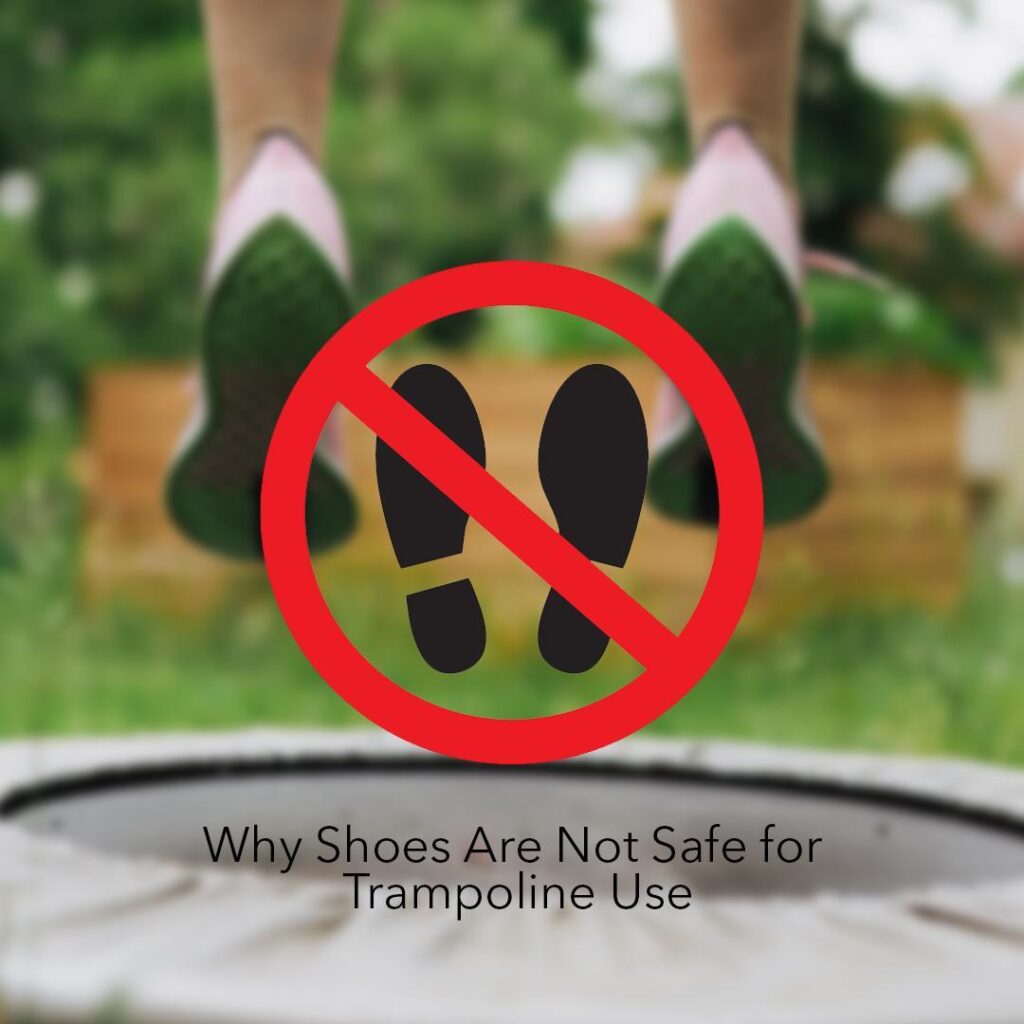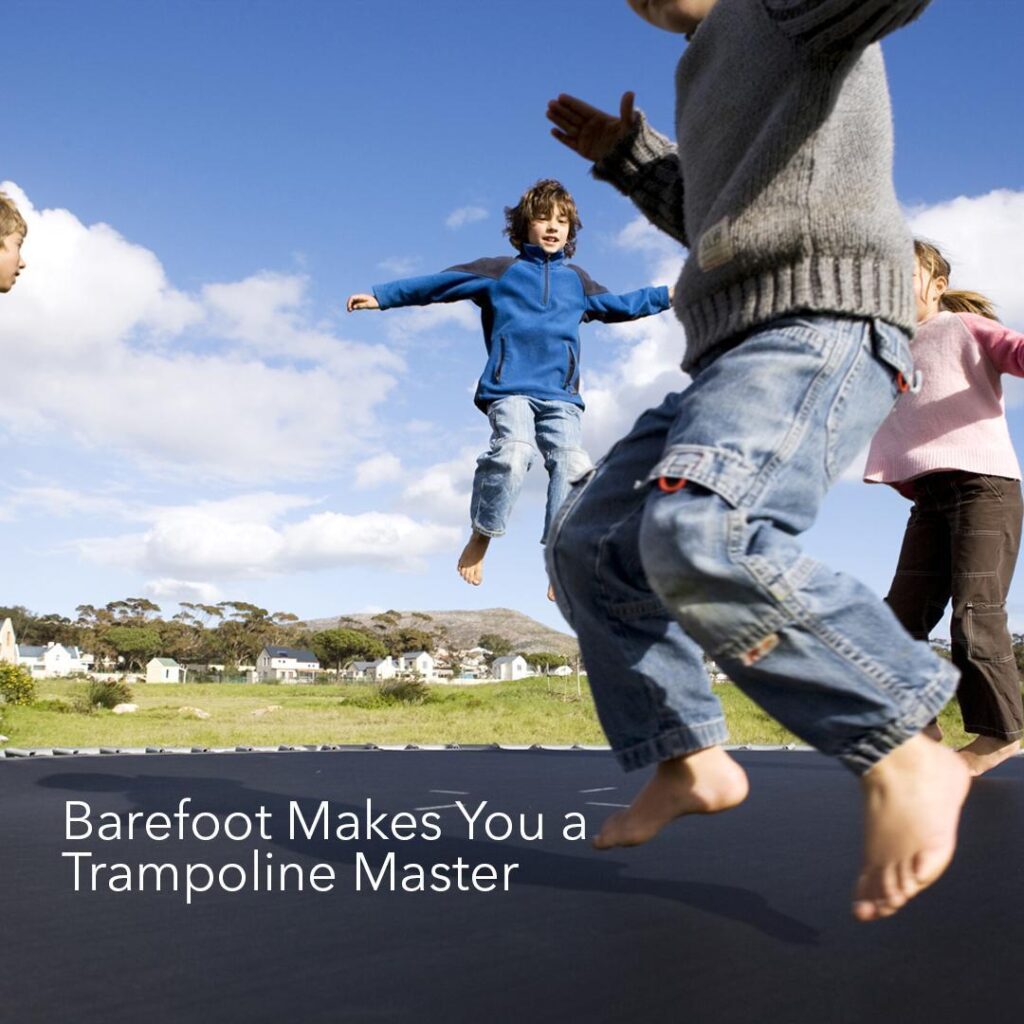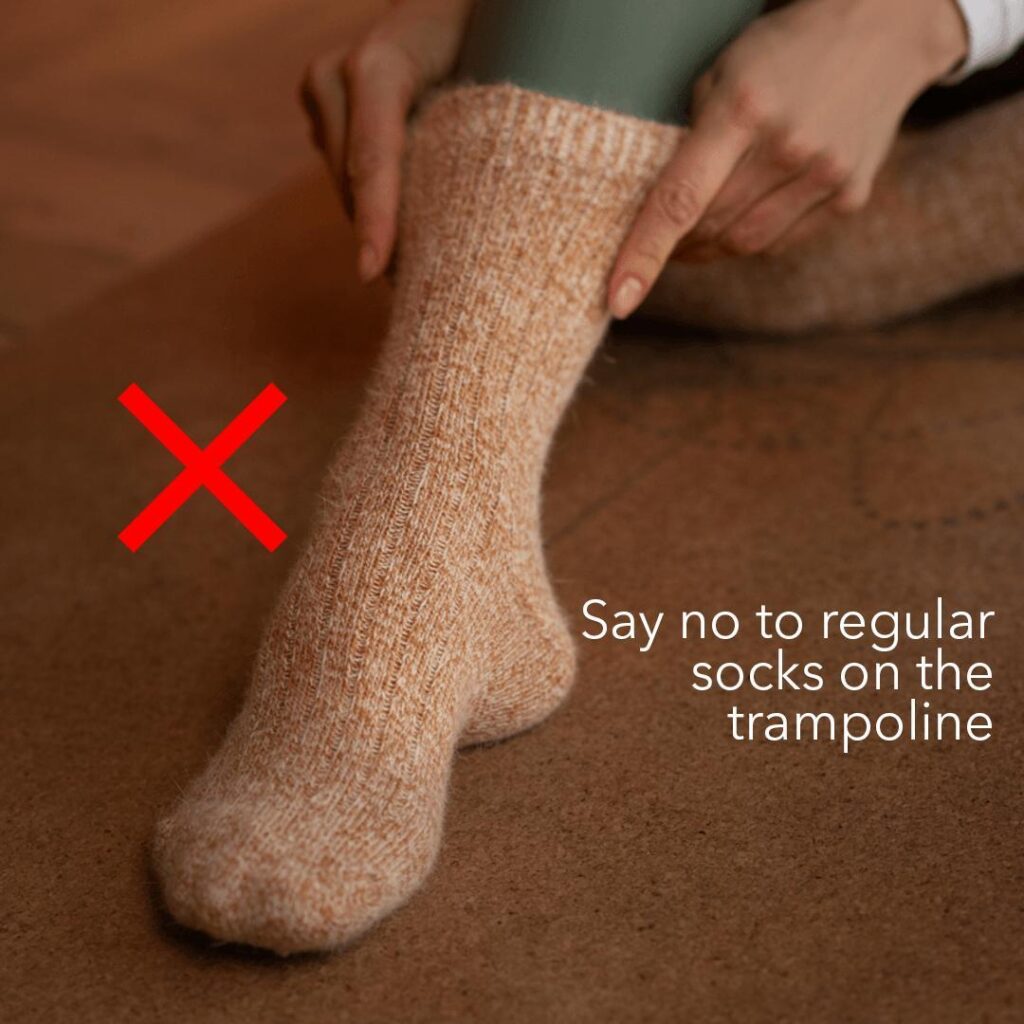Due to its enjoyment and health benefits, trampoline jumping has become more popular among adults and children alike. The thrill of vaulting high into the air is a universal attraction, whether it be in gardens or trampoline parks. On the other hand, your trampoline experience might be strongly affected by the footwear you wear.
While many might instinctively wear shoes or socks for protection, there’s a compelling argument for going barefoot. Bouncing barefoot on your favourite trampoline isn’t just about feeling the wind between your toes; it’s about engaging your foot and ankle muscles fully.

Did you know that there are twenty-nine muscles associated with each foot and ankle?
Yes it is true. By deciding to jump barefoot, you’re allowing those 29 muscles to stabilise your body on the trampoline’s unstable surface. In this blog, we’ll explore why barefoot bouncing is not only safe but superior to jumping with shoes. From improved balance to enhanced performance and safety, barefoot bouncing offers numerous benefits that make it the best way to fly on a trampoline. So, discover why your next trampoline session should be a shoeless adventure!
Why Shoes Are Not Safe for Trampoline Use
In-ground Trampolines offer a fun and exhilarating way to exercise, but safety is a top priority. Here are the key reasons why shoes are not safe for trampoline use:

Increased Risk of Injury
- Reduced Flexibility and Grip: Shoes, especially those with rigid soles, limit the natural movement of your feet. This reduced flexibility can make it harder to balance and maintain proper footing on the trampoline, increasing the risk of falls and injuries.
- Slips and Falls: The soles of shoes can be slippery on the trampoline surface, particularly if they have smooth bottoms or are worn. This increases the likelihood of slipping, leading to potential falls and accidents.
- Ankle Support Issues: While shoes provide support on solid ground, they can restrict the natural flexing of your ankles on a trampoline, making you more prone to ankle sprains and twists.
Damage to the Trampoline
- Surface Wear and Tear: Shoes can cause significant wear and tear on the trampoline mat. The hard soles can create abrasions and weaken the material, leading to tears and holes that compromise the trampoline’s safety.
- Spring and Frame Damage: Jumping with shoes can exert uneven pressure on the springs and frame, leading to potential damage. This can shorten the lifespan of the trampoline and require expensive replacements or repairs.
Hygiene Concerns
- Germs and Bacteria: Outdoor shoes can carry germs and bacteria that you wouldn’t want on your family trampoline, especially if it’s used by multiple people, including children.
Compromised Performance
- Hindered Movement and Tricks: Performing tricks and stunts on a trampoline requires accuracy and control. Shoes may cause problems with these motions by increasing unneeded weight and decreasing foot flexibility, which makes it more difficult to perform and land tricks safely.
Foot Health Considerations
- Natural Foot Development: For children, barefoot bouncing supports natural foot development and strengthens muscles, tendons, and ligaments. Shoes can interfere with this process by constraining the feet.
- Improved Sensory Feedback: Barefoot bouncing enhances proprioception. This improved sensory feedback helps with balance and coordination, which is crucial for safe sport trampoline use.
For these reasons, shoes are not safe for trampoline use. Opting to bounce barefoot provides a safer, more enjoyable, and effective experience.
Now, let’s delve into why ditching shoes makes you a trampoline master.
BarefootMakes You a Trampoline Master

Trampoline lovers are aware that their feet are crucial to perfecting their jumps and tricks. When trampoline jumping, taking off your shoes can improve your performance and overall enjoyment. This is the reason why:
Enhanced Balance and Stability
Going barefoot allows for better contact with the trampoline surface. This direct contact enhances your balance and stability, as your feet can naturally grip and adjust to the mat. Barefoot bouncing engages all the muscles in your feet and ankles, allowing them to work in harmony to keep you steady and agile.
Superior Control and Precision
Barefoot bouncing provides a heightened sense of control and precision. Without the bulk and constraints of shoes, your feet can move more freely and naturally. This freedom is crucial for executing complex tricks and stunts with accuracy. You’ll be able to feel the exact moment your feet hit the mat, allowing for quicker and more precise adjustments mid-air.
Better Performance and Higher Jumps
Shoes can absorb some of the energy that should be operating you upward, but bouncing barefoot maximises energy transfer. This means higher jumps and more powerful bounces. The natural flexibility of your feet helps to optimise the push-off from the mat, giving you more height and allowing you to perform aerial manoeuvres more effectively.
Increased Proprioception and Body Awareness
Your body’s capacity to perceive its own location and motion is known as proprioception. Barefoot bouncing significantly enhances this sensory feedback, helping you to be more aware of your body’s alignment and movements. This increased awareness can improve your coordination and timing, essential elements for safe and successful trampoline activities.
Foot Health and Strength
Not only does it feel amazing, but bouncing barefoot is good for your feet. It strengthens the tendons, ligaments, and muscles in your ankles and feet and promotes normal foot development. Given that it promotes healthy growth and development, this is particularly crucial for youngsters. It supports the maintenance of robust, flexible feet in adults.
Reduces Wear and Tear
Shoes can seriously harm the trampoline mat and springs, especially those with hard soles. By removing this risk, barefoot bouncing helps the trampoline last longer and in excellent condition. This keeps the trampoline in good condition and guarantees a reliable and secure jumping experience.
Clean and Hygienic Trampoline
The trampoline’s surface can become unclean and even hazardous due to the tracking of dirt, mud, and germs by shoes. You can help to maintain a more secure and hygienic environment for all users of the trampoline by going barefoot.
Ditching your shoes while bouncing on a trampoline offers numerous benefits that enhance your performance, safety, and overall enjoyment. So next time you head for a jump, kick off those shoes and experience the full potential of your trampoline skills!
Now, let’s explore why wearing socks can affect your trampoline experience.
Say no to regular socks on the trampoline

Wearing socks on a trampoline might seem comfortable, but it can lead to several issues affecting safety, performance, and enjoyment. Here are the key disadvantages:
-
Risk of Slips and Falls
- Poor Traction: Regular socks, especially without non-slip grips, provide minimal traction, increasing the risk of slipping and injuries.
- Smooth Soles: Typical socks lack the necessary friction to stay stable on the trampoline mat.
-
Reduced Balance and Stability
- Instability: Socks can shift or bunch up, causing instability and making it harder to maintain balance.
- Less Sensory Feedback: Socks reduce direct contact with the mat, diminishing the sensory feedback needed for quick balance adjustments.
- Limited Flexibility: Socks restrict natural foot movement, making it harder to perform tricks and stunts.
-
Hygiene Concerns
- Heat Build-Up: Socks trap heat, making feet hot and sweaty, causing discomfort and distraction.
- Sweat and Odour: Socks trap sweat, leading to unpleasant odours and bacteria growth.
- Germs Transfer: Socks can transfer germs and bacteria, especially in shared environments.
- Bunching and Shifting: Socks can bunch up or move, causing irritation and missteps.
Wearing socks on a trampoline presents several disadvantages, from increased risk of slips and falls to reduced balance and stability, as well as discomfort and hygiene concerns. For a safer, more comfortable, and enjoyable bouncing experience, consider going barefoot or using specially designed trampoline socks with non-slip grips. This way, you can maximise your performance, maintain better balance, and fully enjoy your trampoline activities.
Conclusion
Bouncing barefoot on in-ground or public use trampolines is more than just a nostalgic throwback to childhood; it’s a superior way to experience the thrill and joy of jumping. By freeing your feet from shoes, you enhance your balance, control, and overall performance, all while promoting foot health and maintaining the longevity of your trampoline. Barefoot bouncing connects you directly to the mat, allowing for a more natural and exhilarating experience.
Give barefoot bouncing a try and feel the difference it makes in your trampoline performance. We’d love to hear about your experiences! Share your thoughts and stories in the comments below, and don’t forget to share this post with fellow trampoline enthusiasts. Ready to take your trampoline skills to the next level? Kick off those shoes and start bouncing barefoot today!
Jumping on a trampoline barefoot is generally safe and offers better grip, but ensures the surface is clean to avoid injuries. Consider using grip socks for added protection and support.
Bouncing on a trampoline is great for improving cardiovascular health, enhancing coordination, and strengthening muscles. It’s also a fun way to boost mood and relieve stress.
The best way to jump on a trampoline is to keep your knees slightly bent, maintain balance by using your arms, and land on the balls of your feet. Always jump in the centre to maximise safety and control.
Bouncing on a trampoline offers a higher-intensity workout that improves cardiovascular health and muscle strength more than walking. However, walking is lower impact and suitable for all fitness levels.
Jumping barefoot on a trampoline can provide better grip and balance, but be cautious of potential injuries. Consider using grip socks for added protection.





